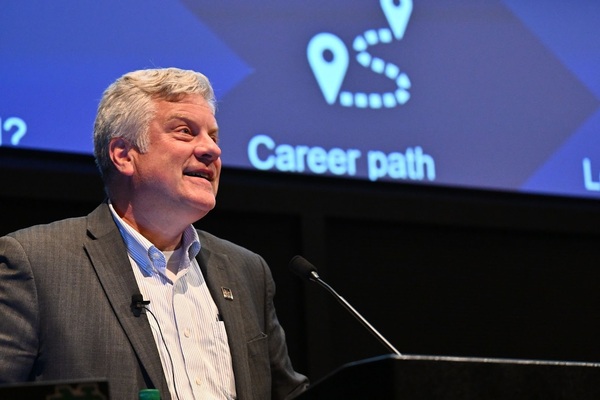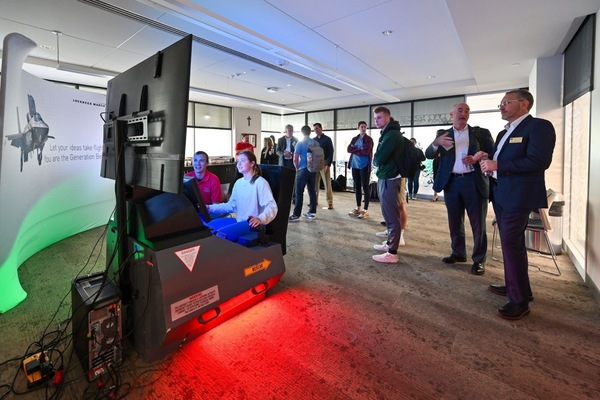
In outer space on a slow journey back to Earth, there is a capsule containing dirt and rocks collected from the surface of the asteroid Bennu. Once the sample arrives and is analyzed, it may answer longstanding questions about the formation of our solar system.
The technology used to collect the sample was created by the Lockheed Martin Corporation. Lockheed Martin engineer Jim Harris developed the design and used a plastic cup, an air compressor, and the gravel in his driveway to conduct the first tests of the device.
This innovation is just one example of Lockheed Martin technology highlighted by alumnus Steven H. Walker on a visit to the University of Notre Dame’s campus in November.
Walker, who earned both his B.S. (’87) and Ph.D. (’97) degrees from Notre Dame, serves as the company’s Vice President and Chief Technology Officer, where he is responsible for technology strategy, global research, mission development, and emerging operations technologies.
Previously the Director of the Defense Advanced Research Projects Agency (DARPA), Walker was elected in 2020 to the National Academy of Engineering for his leadership in research and development for national defense. He also received the Distinguished Graduate Alumni Award from Notre Dame in 2018.
A career takes flight
In his address to students, “Securing Our Nation in the 21st Century: This is What I’m Fighting For,” Walker explored the connections between research and aviation that have driven his career. A native of Dayton, Ohio, Walker grew up near the Wright-Patterson Air Force Base. As a Notre Dame undergraduate he studied aerospace engineering while also taking part in the Air Force Reserve Officers' Training Corps (ROTC) program.
After returning to Notre Dame for his Ph.D., Walker worked as special assistant to the director of Defense Research and Engineering and was present in the Pentagon during the September 11 attacks. Walker said the experience drove him to dedicate more of his efforts to improving the nation’s hypersonic defense capabilities.
Walker explained that much of his current work at Lockheed Martin aims at deterring national adversaries. “We are trying to take the posture of being a lot more adaptive, agile, and surprising to future adversaries,” he said. “When we do that, potential adversaries will understand that taking that first step to war is not worth it.”
In addition to discussing technology and national defense, Walker shared practical advice with students along with lessons he has learned throughout his career. He encouraged students to develop expertise early, to think big, and to invest in relationships.
Walker also shared another lesson he learned during the September 11 attacks. “You never know when it is your last day here on Earth,” he said. “The airplane could have easily gone into the other side of the Pentagon, and I would not be here talking with you today.” His advice was to “Seize the day, make it valuable, do something impactful.”
Collaborating for excellence in aerospace technology
Walker’s visit to Notre Dame came as part of an ongoing partnership between the University and Lockheed Martin that began in November 2021.
A key focus of the partnership is collaborative research, especially in areas of shared interest, such as hypersonic flight and wireless technologies. Walker said, “Lockheed Martin’s partnership with Notre Dame is not only accelerating technical innovation in support of national security, but allows us to work with the very best and brightest as we cultivate our future workforce. University relationships like this are an essential component of our collaborative ecosystem to deliver 21st century capabilities for our customers.”
Lawrence Schuette, Lockheed Martin Director of Global Research and Innovation, shared that “the University of Notre Dame provides the Corporation with excellent researchers, a high quality and collaborative administration and, most importantly, with students who are well educated in their fields, but also have great emotional intellect and thus can work, learn and grow as part of team.” He added that “Lockheed Martin Corporation is truly a ‘team of teams’ and we welcome the collaboration with the University of Notre Dame.”
Robert J. Bernhard, Notre Dame’s Vice President for Research and professor in the Department of Aerospace and Mechanical Engineering, said, “We are grateful for Lockheed Martin’s partnership, which helps us to ensure that the pioneering discoveries made here at Notre Dame have an application. We believe this partnership is a significant benefit to our faculty and students.”

Patricia L. Clark, Associate Vice President for Research and professor in the Department of Chemistry and Biochemistry at Notre Dame, added that “Lockheed Martin has been a tremendous collaborator. Together with Lockheed Martin’s researchers, Notre Dame faculty are solving some of the most important engineering problems posed by hypersonic flight, wireless technologies and other areas of national need.”
Lockheed Martin’s visit included opportunities for students to learn about careers in aerospace technology and even the chance to take (simulated) flight. The Lockheed Martin team made one of its F-35 Flight Simulators available for student use inside Notre Dame’s Duncan Student Center during the visit.
Contact:
Brett Beasley / Writer and Editorial Program Manager
Notre Dame Research / University of Notre Dame
bbeasle1@nd.edu / 574.631.8183
research.nd.edu / @UNDResearch
About Lockheed Martin:
Headquartered in Bethesda, Maryland, Lockheed Martin Corporation is a global security and aerospace company that employs approximately 115,000 people worldwide and is principally engaged in the research, design, development, manufacture, integration and sustainment of advanced technology systems, products and services. Follow @LMNews on Twitter for the latest announcements and news across the corporation.
About Notre Dame Research:
The University of Notre Dame is a private research and teaching university inspired by its Catholic mission. Located in South Bend, Indiana, its researchers are advancing human understanding through research, scholarship, education, and creative endeavor in order to be a repository for knowledge and a powerful means for doing good in the world. For more information, please see research.nd.edu or @UNDResearch.